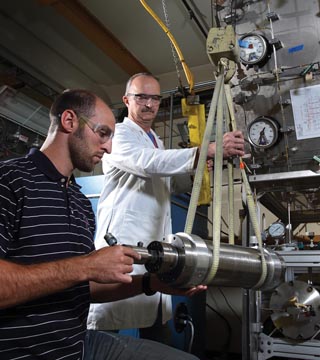
Hydrogen embrittlement, the process by which metals become less ductile and more susceptible to fracture during exposure to hydrogen, is a problem that has vexed scientists for more than a century. As a small and highly mobile molecule, it seems that nothing can stop hydrogen from working its way into and degrading any structural material, especially high-strength materials — except perhaps hydrogen’s water partner, oxygen.
“In the materials science community, there has been some discussion that hydrogen embrittlement can be inhibited or even stopped when certain gas species are blended with the hydrogen, even at parts per million quantities,” says principal investigator Brian Somerday (8252). “Oxygen is one of those gas species.”
Brian and Joe Ronevich (8252) had the opportunity to put this theory to the test in the Hydrogen Effects on Materials Lab through a collaborative project with the US Army Armament Research, Development and Engineering Center (ARDEC), headquartered at Picatinny Arsenal, N.J. ARDEC is developing a
next-generation artillery technology, the Combustion Light Gas Gun (CLGG), that propels projectiles through the combustion of hydrogen and oxygen.
The CLGG substitutes gaseous hydrogen and oxygen for traditional gun propellant. Combustion gases are significantly lighter than those used in a conventional gun, permitting considerable increases in muzzle velocity. This results in the potential for greatly extended range and about 11 times the coverage of conventional artillery. Using hydrogen as the primary propellant has other advantages, like environmentally benign steam as the combustion byproduct. Hydrogen can also be rendered harmless by venting the gas into the atmosphere, and the gas has the added advantage of dual use: as a gun propellant and a fuel to power military vehicles.
But with hydrogen comes hydrogen embrittlement, exacerbated by the high-strength materials of the CLGG. The wild card is the added presence of oxygen, a necessary component of ARDEC’s combustion scheme.
“This raises a fundamental science question,” says Brian. “Can the oxygen present mitigate the inevitable hydrogen embrittlement? And if so, can you quantify that effect? From a science perspective, we think what we are doing to define the boundaries and variables that promote this inhibition is unique.”
He was well-prepared when the call came from ARDEC. In a recent project for the DOE Fuel Cell Technologies Office, Brian has been working to quantify the mitigating effects of oxygen on hydrogen-assisted crack growth in steels for hydrogen pipelines. “We have some experience now in mixed-gas tests, as opposed to pure hydrogen, which we were able to apply immediately to ARDEC’s problem,” he says.
ARDEC represents a new type of customer for Sandia’s core capability in hydrogen embrittlement. This research originated in the nuclear weapons program, specifically for gas transfer systems components. Over the last 10 years, Sandia has successfully applied this expertise to the hydrogen energy arena. “This project applies that core capability to a dimension of hydrogen embrittlement that has not been explored in much depth,” says Brian.
The oxygen effect
In April, Joe conducted a series of experiments for ARDEC in the Hydrogen Effects on Materials Lab. In 100-hour tests, he compared the effects of pure hydrogen against hydrogen with 0.5 percent O2 on two different high-strength materials, martensitic steel and a nickel-based superalloy.
“In the samples tested in pure hydrogen, we saw what we expected — the propagation of cracks quite quickly,” says Joe. “In the samples tested in mixed gas, we still saw crack propagation, but there was a significant time delay. These results were intriguing because the time delay indicated that oxygen had some mitigating effect, but the hydrogen embrittlement was not absolutely inhibited.”
In the pure hydrogen, cracks developed in both the martensitic steel and nickel-based superalloy within minutes. In the mixed gas, cracks did not begin to develop in the martensitic steel for more than 94 hours and in the nickel based superalloy for over one hour.
In September, Joe ran another series of experiments on a different martensitic steel that was heat-treated to two distinct strength levels and subjected to a hydrogen/1 percent oxygen mixture for 100 hours.
“This was an interesting result,” says Joe. “We anticipated that doubling the concentration of oxygen would have a higher inhibiting effect, but that is not what we saw. In both pure hydrogen and the mixed gas with 1 percent oxygen, the time for crack initiation ranged from minutes to hours, depending on the steel strength and applied stress level. The mitigating effect of oxygen was most pronounced for the low-strength steel, in which the onset of crack initiation in the mixed gas was about 40 times longer compared to the pure hydrogen.”
Brian anticipates that a third series of experiments could start soon, this time looking at the effects of a hydrogen/oxygen mixture on high-strength materials with a cycling mechanical load.
“The delay in crack propagation that we saw could be specific to these high-strength structural materials,” says Brian. “Or, on a different class of structural materials, maybe the inhibition effect is absolute. These results inform our understanding and endorse the value of this avenue of research. We could be looking at the hydrogen embrittlement problem in a very different way.”